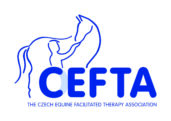Hippotherapy for babies and safety
Primum non nocere! All professionals know this spell perfectly well. Do benefits arising from the chosen procedure outweigh the possible risks? This uncertainty has been included in every responsible decision-making. Weighting benefit over possible harm is getting quite different dimension during hippotherapy. Upon careful evaluation and treatment done by an experienced physical or occupational therapist, we can almost eliminate any harm to the child due to the direct effect of the impulses transmitted from the walking horseback. Less clear is answer to the question: How safe is to be placed on a horse?
Safety
In hippotherapy in early care, the safety of infants and toddlers is provided by securing them on both sides while positioned on the horse in developmental lower positions. It requires constant contact with the child and professional team collaboration. Physical and occupational therapists take full responsibility and deal with all possible emergency situations. The whole hippotherapy team must be familiar with the safety and emergency policies and procedures.
The question of the using riding helmets during hippotherapy has always been discussed. We are always using a helmet for children in compliance with these rules:
- have a good trunk and head control,
- have an active firm hand grip,
- do not have instability of the atlanto-occipital joint,
- wearing helmet doesn´t provoke any undesirable pathology.
Exceptions for non-wearing a riding helmet during hippotherapy are:
- child early age (maily infants),
- child developmental age under 8 to 10 months,
- children with a significant hypotonic muscle tone,
- children with a strong dismissive attitude towards wearing a helmet.
We also do not recommend wearing a riding helmet for certain positions on a horse, see the charts (download in PDF – riding helmets chart).
Chart 2 – using riding helmets during hippotherapy
Fortunately, advanced technologies have been progressing in our favour. On the market, there are lot of ultra light riding helmets respecting the child physiognomy. If the helmet is not used during the hippotherapy treatment session, the parent or legal guardian is fully informed of the risks and has to sign a written consent prior to enrolling the child in the program.
The overall safety during hippotherapy treatment session can be improved by using tools such as safety belts, specially adapted handles or easily removable aids on the saddle pad for example an overball, etc.
Risks

Safety – all equipment used during hippotherapy treatment session is possible to easily and fast remove.
A big importance is paid to safety in hippotherapy and the therapist is required to consider all risks possibilities, in order to prevent any complications. The most common risks in hippotherapy include:
- not recognition or ignorance of physical and coordination fatigue of the child´s body, leading to the increase of pathological movement patterns,
- incorrect selection of position on the horseback, too fast or too slow pace of the horse gait, poor choice of terrain during treatment session,
- improper therapy horse selection (type of horseback movement, intensity, height, width, poor movement stereotypes, etc.),
- mounting and dismounting a child,
- poor functional diagnostics or overestimated child abilities,
- using a horse without special hippotherapy training,
- working with a horse handler without experience and skills,
- underestimation of the application safety rules in hippotherapy and movement around horses,
- underestimation of the parent/legal guardian awareness regarding the principles and conditions for the therapy implementation,
- injury caused by a fall from a horse or a horse kick.




